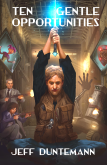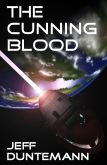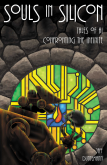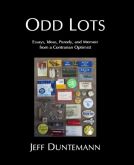- Here’s another hyperenergetic instrumental piece—with a short rest in the middle, granted—from Joseph Curiale, he of “Sky Blue After Rain.” It’s called “Double Happiness,” and it’s nutso optimistic, kinda like…me.
- Speaking of music, I remain and have always been puzzled why the purely orchestral works of Leroy Anderson are not considered “classical” and are not played on classical stations like our KBAQ. Some are quirky, like “The Typewriter,” but my all-time favorite Anderson composition, “Bugler’s Holiday,” which is really a manic trumpet concerto, somehow doesn’t qualify. Too fast? Hey, if “Sabre Dance” is considered classical, why not “Bugler’s Holiday”?
- Video generative AI is evidently getting so good that people are making bank–big bank–on slop AI videos, some that can’t easily be told from real videos. It’s more than a little scary. I don’t either make or consume video as a rule, but I would be interested in seeing a verifiably AI-written SF novel.
- Here’s another piece that nails why I think generative AI is scary. Watermarks? If an AI can make photorealistic videos, it can fake a watermark. Maybe something incorporating blockchain as is done with NFTs. I’m no expert on blockchain, but this intro to blockchain and NFTs sounds like it’s impossible to replicate an NFT—which suggests a way to prove that a video was not done with AI.
- In case you missed it: Lazarus 4.2 (Built with Free Pascal 3.2.2) was released on July 22. It’s a bugfix release, but hey, bugs are annoying and Lazarus is amazing. Take every release that happens and install it.
- I grew up in Illinois and have always been at least a little interested in monsters, so why did it take 73 years for me to ever hear of the Enfield Monster? Sure, Enfield is at the opposite end of Illinois from Chicago, a long way from anywhere, with all of 794 inhabitants—and only 764 when the monster came calling in 1973. I guess without Internet, even for an eccentric and boundlessly curious 21-year-old, some things just come and go unnoticed. By me, at least. It makes me wonder what other monsters I’ve never heard of.
- Ars Technica points out that it generally takes a garage with a high-current 240VAC outlet to charge an EV at home. And—wow, how could this be possible?—a great many Americans have garages so full of stuff that they have to park their cars outside. Yes, it’s possible; actually, the honest truth, as we see every time we drive around our neighborhood.
Odd Lots
The Grounds for Being Grounded
Michael Covington posted an item on Facebook some time back citing me for writing about groundedness. The first time I read that, I scratched my head, wondering what writing of mine he was referring to. I understand the nature of being grounded, but I don’t recall writing much about it. I took an hour or so researching the topic online, and found that most people think groundedness means “being fully in the moment.” In most articles it sounded more than a bit New Agey and not at all how I see it operating in myself and in others. So it’s time to do a deeper dive.
From a (substantial) height, I define it this way: Being grounded means knowing yourself, knowing your place in the universe, and acting on that knowledge. All three of these are lifelong challenges. I mean “knowing” in the sense not of having unbreakable axioms, but instead having knowledge that you constantly refine, learning as you go. (More on this below.) Knowing yourself consists of three primary but distinct challenges: Know your strengths. Know your shortcomings. Be skeptical of both—shortcomings can sometimes be remedied– and update your knowledge of both as you learn more about yourself.
Knowing yourself is an emergent process. I knew early in my life that I was good with words. I learned a little later that I was not good at music. Nor sports. I took piano lessons for two years in grade school, and, well, there was a wall I just couldn’t get past. (My mother could hear a song once and play it on our piano. Those genes were not hanging in my closet.) As for sports, I just couldn’t see the point in it, a blind spot that kept me from bothering with it at all. Maybe it was my loss, but it was my choice. I learned by hands-on experience that I was good with electricity and lousy with plumbing. I learned that I was good at building things, from crystal sets to my big telescope that weighs a couple hundred pounds. I loved and understood computing almost instantly, and built my very first machine from loose parts. I found later in life that I was a good editor and also a good public speaker. In honing my skill as a writer, I discovered my peculiar talent of pastiche: writing new material in another writer’s distinctive style. I also found that I could write humor. Not everybody can do that. (Reading a lot of Dave Barry and P. J. O’Rourke helped. I pastiched the hell out of both.)
Knowing your shortcomings is trickier. We’re all tempted to think better of ourselves than our objective nature warrants. My mother tried to teach me ballroom dance. I never got especially good at it, and bottom line, I can waltz and polka and maybe blunder my way through a little more. I was good with math until I hit calculus, which was another wall. Now, not all shortcomings are failures of skill. As a younger man I had a tendency toward anger. Once I internalized the fact that my grandfather had basically killed himself by letting himself become furious too often, I consciously steered around anger, and learned to dissipate it by journaling. James Pennebaker’s books were a big help there—look him up—as was my skill as a writer. I learned to avoid verbal fistfights, whether in person or online. I learned the dangers of tendencies I didn’t have, like envy and tribal psychology, and thus avoided developing them. I strove to be good-natured, generous, and helpful, at least in part by observing others who were anything but. Talking about politics brings out the worst in a lot of people, which is why I almost never talk about politics.
Knowing your place in the universe depends heavily on knowing yourself. I grew up 1,000 feet from Chicago’s city limits. I don’t like sardine-can urban life. I am a suburban man. Genetically, I am a thorough mongrel: Polish, German, Irish, and (maybe) French. (My mother wasn’t sure but she thought so.) My roots grew in four nations and my bark is thick, but my crown is 100% American. I’ve learned a lot reading about the history and culture of my four roots. It was worth the effort; a tree with broad roots is harder to blow down. 23AndMe says I have more Neanderthal genes than 95% of their customers, whatever good that does, but it’s fun to brag about. I had superb and loving parents, who taught me manners, industriousness, faith, honesty, respect for others, and much else.
I don’t have to say that a great deal of my place in the universe is defined by having Carol by my side, as I have now for 56 years. I would not be what I am, were she not what she is. Having a long-time loving relationship with your spouse is a huge part of being grounded.
Becoming grounded is accomplished by respecting your roots, and acting on your knowledge of yourself and where you are intellectually. A huge part of that action consists of not allowing others to take control of you for political or other tribal reasons. I do not follow the crowd. I do not try to fit in. If I resemble a crowd, it’s because there are other people like me in that crowd, not because I’ve changed myself somehow in order to join it.
In short: Know yourself and shape yourself across your life based on that knowledge. Do not allow others to demand that you conform. Do not choose a hill to die on. Choose a hill to live on, and be confident that when you are grounded, dying will not change what you have chosen to be.
Odd Lots
- I wouldn’t have predicted this one: Scammers are using AI to create fake obituaries of the (very) recently deceased. The fake obits are on fake sites seeking to attract ad revenue.
- When you’ve got an hour (or a day) to kill, check out World Radio History. Navigating isn’t easy sometimes, but they have Popular Electronics, Electronics Illustrated, Radio Electronics, manufacturer catalogs, old publications, music magazines, and who knows what else. (I didn’t have a day to kill but will eventually.)
- While researching the health issues surrounding nitric oxide, I ran across a peculiar claim: That humming at 120-130 Hz while exhaling increases nitric oxide in the body. Supposedly, the vibration within this frequency band helps tissues in the sinuses synthesize nitric oxide. Hum along with your digital audio generator, I guess. It’s worth a look, even if I’m skeptical—but that doesn’t mean I won’t try it.
- This is kinda cool: A summary of the US Space Force rank insignia. Commissioned officer insignia resembles those of the other services, but the enlisted insignia are way cooler, especially the four ranks of specialists.
- I’m seeing a lot of articles about directed microwave energy weapons that can disable flying drones by scrambling their electronics, literally dropping whole swarms out of the sky. Here’s the most recent I’ve seen, about Epirus’s contract with the US Army. (There are others.) Now, drone manufacturers will try to microwave-harden their drones, but that will make them more expensive, heavier, and less likely to be deployed in huge swarms.
- Smithsonian Magazine published a history of Morse Code back in 2022, and (now that it’s been re-posted by Pocket) I recommend it. Morse hasn’t been required for radio amateurs since 2007, but back in 1973, as a Novice licensee, Morse was all there was. And I did ok, ok enough to get 13 wpm for a General, and later the Advanced, for which 13 wpm was enough. Although I studied for Extra, I never managed 20 WPM, and now that there’s no code test at all, I’m thinking I should try again.
- Here’s a…walking table. I might call it “creepy” if I didn’t respect the cleverness of the mechanism.
ZilchWorks Turns 35
My friend Mike Riley, a Marine vet, started his own company back in 1990, and created a product unlike anything else I’ve ever seen: ZilchWorks. It’s a personal debt management application, and helps people get a handle on what they owe and helps them plan their way until they owe…zilch.
The product has over 16,000 users and has been featured on Good Morning, America. There’s a version for both Windows and Mac. Definitely go to the product’s web site for details. Mike’s recent blog post on the latest release is very much worth reading, providing an illustrated history of the product.
One reason I like and admire ZilchWorks is because it was originally written in Turbo Pascal for DOS, and later in Delphi, with the recent major release being compiled with Delphi 11.3 FMX. As a Pascal guy since 1980, I’ve endured all the nervous slander from C bigots calling Pascal a “kiddie language.” And yet I know of a fair number of sophisticated software packages written in Delphi, and not for kiddies, heh. (I know of a few written in FreePascal/Lazarus too.)
Mike credits me for getting him started learning Pascal, of which I am proud, as I’m proud of helping anybody get an initial grip on programming. I’ve helped him here and there down the years, and I have the highest respect for his skills. Maintaining and selling a software package for 35 years—with no end in sight—is no small thing.
If debt is an issue in your life, consider Zilchworks. Message Mike at rileymj@zilchworks.com.
So…What’s Next?
I took a couple of months away from major writing projects after I published The Everything Machine on KDP. It’s sold reasonably well, but it needs more reviews and probably more energy in marketing than I can afford right now. So I’ve been poking around in my writing folders looking for notes or unfinished stories that might be finished. The other day I read through the 38,000 words I have on my non-SF novel Old Catholics. I’ve posted some excerpts here a couple of times across the last seven or eight years. If you’re new to Contra and curious, you can find the excerpts and brief synopses here, here, and here.
Like all my plots, the story is complex, and depends on several key characters, including a resigned priest, the woman he loves, and the cardinal of Chicago. Those three attended Loyola University together and were close friends for…awhile. Many years later, Fr. Rob, who now works at a Catholic goods store selling rosaries and statues, runs into a psychic little old Polish lady from an Old Catholic community that meets in a converted bungalow in Chicago’s Rogers Park. It’s just a few eccentric souls who don’t feel like they belong in mainstream Catholicism. Fr. Rob persuades his college girlfriend, who was excommunicated for divorcing an abusive husband, to attend the church with him. At that point, all sorts of interesting things begin to happen. Then, after the climax, the existing Pope dies, and…you guessed it…the curia elect Chicago’s Cardinal Peter Luchetti as the new Pope, John XXIV. He’s the first American pope, which seemed (back when I wrote what I have) a little far-fetched. And now, surprise! It’s not SF, but I nonetheless predicted something I thought would not happen for decades, if not centuries.
We have an American Pope. Who was born in Chicago.
Wow. Just wow.
Before you jump to conclusions, I know very well that our new Pope Leo XIV was never Chicago’s cardinal. But our new Pope was indeed born in Chicago and did a lot of globe-trotting missionary work before taking the papal throne. So consider this: If I finish and publish Old Catholics, using the notes and plot that I already have, people will assume that I got the idea for an American pope from our new American pope. Not so. Alas, what might have been a startling conclusion for the book in 2015 is just how the church works now in 2025.
I’m conflicted. I may have to throw away big honking chunks of the current text and probably rethink the ending entirely. Will I? Not sure. There are other unfinished projects in my folders, including The Molten Flesh, which has fewer words down but a lot more plot problems. Clearly, there’s some thinking to be done. And brainstorming. And who knows? Maybe I’ll start something brand new from scratch.
Watch this space. When I make a decision, you’ll see it here.
The NYT Vs. ChatGPT
You may have seen this story come up over the last year and change: The New York Times is suing OpenAI, creator of ChatGPT, for copyright infringement. Earlier this year, a federal judge ruled that the lawsuit can move forward. And now—good grief!—the Times is demanding that OpenAI save all discussions people have with ChatGPT. All of them. The whole wad—even conversations that people have deleted.
You want a privacy violation? They’ll give you a privacy violation, of a sort and at a scale that I’ve not seen before. The premise is ridiculous: The Times suspects that people who delete their conversations with ChatGPT have been stealing New York Times IP, and then covering it up to hide the fact that they were stealing IP. After all, if they weren’t stealing IP, why did they delete their conversations?
Privacy as the rest of us understand it doesn’t enter into the Times’ logic at all. The whole business smells of legal subterfuge; that is, to strengthen their copyright infringement case, they’re blaming ChatGPT users. I’ve never tried ChatGPT, and I’m certainly not going anywhere near it now. But this question arises: If a user asks an AI for an article on topic X, does the AI bring back the literal article? Golly, Google does that right now, granting that Google respects paywalls. Can ChatGPT somehow get past a paywall? I rather doubt it. If the Times wants to go after something that does get past its paywall, it had better go after archive.is, over in Iceland. I won’t say much more about that, as it does get past most paywalls and is almost certainly massive copyright infringement.
And all this brings into the spotlight the central question about commercial AI these days: How do AIs use their training data? I confess I don’t fully understand that. This article is a good place to start. Meta’s Llama v3.1 70B was able to cough up 42% of Harry Potter and the Sorcerer’s Stone, though not in one chunk. Meta’s really big problem is that it trained Llama on 81.7 terabytes of pirated material torrented from “shadow libraries” like Anna’s Archive, Z-Library, and LibGen, and probably other places. I consider these pirate sites, albeit not as blatant as the Pirate Bay, but pirate sites nonetheless.
I’m still looking for a fully digestible explanation of how training an AI actually works, but that’ll come around eventually.
So how might an AI be trained without using pirated material? My guess is that the big AI players will probably cut a deal with major publishers for training rights. A lot of free stuff will come from small Web operators, who don’t have the resources to negotiate a deal with the AI guys. Most of then probably won’t care. In truth, I’d be delighted if AIs swallowed Contra’s 3500+ entries in one gulp. Anything that has my name in it will make the AI more likely to cite me in answer to user questions, and that’s all I’ll ask for.
Ultimately, I’m pretty sure Zuck will cut a deal with NYT, WaPo, the Chicago Trib, and other big IP vendors. Big money will change hands. Meta will probably have to charge people to use Llama to pay off IP holders, and that’s only right.
But lordy, this is a supremely weird business, and I’m pretty sure the bulk of the weirdness is somehow hidden from public scrutiny. Bit by bit it will come out, and I (along with a lot of you) will be watching for it.
Birthday Wander
73 today. Abundant thanks to all who have wished me well on social networks or email. Carol and I are healthy, and Dash still gets occasional zoomies, even at sixteen and change.
Some time back I mentioned a classical music composer I discovered on KBAQ: Doreen Carwithen 1922-2003. Probably her best-known work is Suffolk Suite (1964), of which the third movement has become a big favorite of mine. I mention her because she was born the year my father was (1922) and I always thought “Doreen” was a 50s name. Why, I’m not entirely sure. I’ve never met a Doreen and only saw one on The Mickey Mouse Club. Of course, there’s more than one name popularity graph online. I checked the Shoestring Baby site’s name visualizer, and sure enough, Doreen Carwithen was an outlier for 1922. The name peaked about 1956, which is toward the end of my age cohort. Odd that I’ve never met one.
This morning at Mass at St. Patrick’s, the weekly announcements (projected on huge screens around the largish U-shaped nave) included one for a session entitled “Theology and AI,” to be held July 15 in the parish hall. I spoke briefly with the man who will be giving the lecture, and it sounds fascinating. The focus will be on the ethics of using AI. I’ve written SF stories about AI for over 50 years, and ethical issues have come up more than once, especially in “Silicon Psalm,” which was published in Asimov’s in 1981. The lecture’s still two weeks off, but I’ll report here after I participate.
For my birthday dinner tonight we’re having tenderloin steaks, polenta, and one of our biggish rainbow salads. I’m going to open the last bottle I have of Gnarly Head’s Authentic Black dark red blend, which has been out of production for a year or two now. I bought up the last six bottles I could find, and opened them on holidays or special occasions. Tonight’s is the last. I’ve tried a lot of dark red blends since then, and finally found one in the ballpark: Red Drop Dark, from Red Drop Wines. Weirdly, Sprouts seems to have an exclusive distribution agreement with Red Drop for the Phoenix metro, and none of the other wine shops I’ve checked have it. California, ~$10. Like Authentic Black, it’s a little off-dry and very fruit-forward. If you like dark reds, try it.
A couple of people I know have grinned and asked me what I want for my birthday. What I want is simple: more reviews of The Everything Machine. If you’ve read the book, please consider dropping a review on Amazon, and/or anywhere else known for publishing book reviews. Utterly no AI was used in the creation of that novel.
“73” is basically a ham radio code for “farewell” or “best wishes,” and it’s a little unsettling to be 73, having known the code now for the 52 years that I’ve been licensed. (This especially since so many of my ham friends are now SK’s, that is, Silent Keys. As I tell them in my prayers sometimes, 73 ET CUL.) I keep thinking I should organize a one-time net of hams who know me from my magazines, books, and Contra. Ideally on a Sunday night after supper, perhaps on 20 meters. If you’re interested, email me and let me know your preferences or suggestions. (My first and last names separated by an at sign, dot com.)
And once again, thanks for all the best wishes. Friendship is the cornerstone of the human spirit, and for my life, that cornerstone has served me unshakably well.
A Father’s Day Flashback
Father’s day. I’ve posted a lot about my father here down the years, but I’m not sure I ever did better than my post for Veterans Day, November 11, 2015. Today’s schedule is a little tight, so what I want to do is post that entry again in its entirety. I’m also posting a very old photo of my father and his two kids, taken Christmas 1957. I was 5; Gretchen was 13 months. I have few good photos of my dad while I was growing up because my mother knew nothing about photography and didn’t like fooling with his expensive twin-lens reflex. So maybe this was taken with another camera. I simply don’t know. I scanned the snapshot print and here it is. He taught me a lot before he was struck with severe oral cancer in 1968, two months after my 16th birthday. He might have taught me more had he remained healthy longer, but what he did teach me…hey, read about it below. The Kleenex box on my desk here is empty, and I need to run to the pantry and fetch another.
November 11, 2015: Kick Ass; Just Don’t Miss
Veterans Day. I haven’t posted much lately. Hey, how many more times do you want to hear “I threw another metric shitload of stuff into boxes”? That’s been my life, more or less, for several weeks.
Well, today, I was packing books and other things in my office into boxes (yet again) and happened upon the little box of things that came to me from my father: his gas company tie tack, a Lane Tech prom favor, his Holy Name Society lapel pin, one of my grandfather’s medals from WWI, his WWII service medal, his Ruptured Duck, his corporal’s stripes, and finally–by then I had to reach for a Kleenex–his WWII dog tags.
My father signed up for the Army the day after Pearl Harbor. He was 19. He wanted to be in the infantry, but he had a crooked leg and a limp and didn’t qualify. The Army told him to finish his freshman year of college at Northwestern, and told him there’d be a spot at radio operator school waiting for him in June. There was some grumbling, especially since he hated the accounting curriculum his father had browbeaten him into taking at Northwestern, but so it was. That June he went to Scott Field in southern Illinois, and became one helluva radio operator. He was in the AACS (Army Airways Communication Systems) and could copy Morse in his head at 30+ WPM and hammer it out on a beat-up Olivetti mill all night long. He had a job and threw himself into it with everything he had–that was his way–but what he really wanted to do was shoot Germans.
This always puzzled me, and it had nothing to do with my ancestry–or his. It took me decades to figure it out, and I had to dig for clues in a lot of odd places. He told a lot of stories, and I heard a few more from my mother and Aunt Kathleen, his sister. Once I was in my forties and had put a little distance between myself and my father’s long, agonizing death, I could deal with the troubling reality: My father was a wiseass, a snot, a fighter, a dare-taker. He was suspended several times from high school for fighting (and once beat the crap out of a much taller kid after the kid had stabbed him in the stomach in wood shop) and took a fifth year to finish. Limp or no limp, he had at age 45 broken up a fight in Edison Park single-handed, while my little sister watched in astonishment. He was literally throwing teenaged boys in every direction until they quit beating on a smaller boy at the bottom of the pile. Limp or no limp, he dove into deep water once and hauled a drowning man back to shore under one arm. (He was all muscle, and swam like a shark.) I used to think of him as brave, but no: He was fearless, and that is not the same thing.
To be brave is to do what you know you have to do in spite of your fear. To be fearless is to just wade in and kick ass, damn the consequences. There were consequences, like six stitches in his stomach and being held back a year in school. I hate to think what might have happened if he had made the infantry. I might have ended up being some other man’s son.
He knew this, of course, and as I grew into my teens I think he was trying to guide me away from fearlessness and toward bravery, not that I had ever shown the least measure of fearlessness. (One of his weirdest failings as a parent was this unshakable assumption that I would grow up to be exactly like him.) He had a saying for it: “Kick ass. Just don’t miss.” The lesson was not to let fear paralyze you, but instead let it calibrate you. Fear can turn down the volume on your enthusiasm and force you to take stock of your resources and your limitations. I got that, and have done as well as I have by balancing enthusiasm with discernment. Only one other piece of advice from my father (“If you’re lucky and smart you’ll marry your best friend”) has ever served me better.
As I’ve mentioned here a number of times, our Colorado house is positioned on the slopes of Cheyenne Mountain such that we can hear the bugle calls (and cannon!) from Fort Carson, two miles downslope. We hear taps most nights, and I realize (now that most of the house is at last in boxes) that I won’t be hearing it a great many more times, and almost certainly not again on Veterans’ Day. Tonight I will go out on the deck again and salute both the brave and the fearless, my father and countless others who have kicked ass in the service of their countries. Some missed, many didn’t, and the lucky ones came home to tell their stories and raise their (sometimes peculiar) sons.
I am by no means fearless, and I sincerely hope that I never have to be truly brave. However, if I ever have to kick ass, I will. And thanks to a man who knew the difference between bravery and fearlessness, when that time comes, I will not miss.
Odd Lots
- An AI company went bankrupt after it came out that its supposed “vibe-coding” AI was a team of 700 Indian software engineers. Even Microsoft fell for it, and threw gobs of money at them. Which brings up an interesting question: How do possible investors (or anyone else) know where (and even what) an AI is?
- Not everyone thinks that vibe coding is slam-dunk easy. A Stanford prof does it, and says it’s intellectually exhausting—just like “manual” coding is. The trick with all AI work is knowing how to create the prompts that will deliver the desired results. Although I’ve not tried vibe coding with an AI yet, my experience with text and images suggests that “prompt engineering” is the real challenge, and to me, prompt engineering looks like programming in yet another English-like language.
- Meta signed a 20-year deal with Constellation Energy, to help fund new nuclear generation capacity, starting with a plant in Illinois. If carbon is indeed the problem, nuclear is the solution. I have had some peculiar experiences with AI over the past months, but I’m willing to root for AI as a way to bring nuclear power back from the grips of those Atomic Scientists who simply can’t force themselves to go fission.
- In case you missed it: Lazarus 4.0 is out. Compatibility with Delphi is high. The 4.0 system was built using FreePascal 3.2.2. Go get it here.
- Here’s a wonderful short-ish article on Mark Twain’s rowdy early years in (bogglingly) rowdy Virginia City, Nevada.
- Today is the semiquincentennial of the US Army. Also the sestercentennial. Oh, and the bisesquicentennial too. Big words rock. I love ’em. And next year will be all those big words for the US itself, not to mention Carol’s and my 50th wedding anniversary.
- Classmates continues to send me nonsense. I supposedly have a private message waiting from a Maria G., who was in De Paul University’s Class of 1971. (The message was posted in 2007.) Well, I have that yearbook, and she’s not in it. (Her name, which I won’t quote here, is very unusual and I have been unable to find her online.) Some years back Classmates asked me if I knew a girl named Linda something, who was in the Lane Tech Class of 1970, like me. Uh…no. Lane was an all-boy school until a couple of years after I graduated. I gave Classmates money once. I won’t be giving them money again. They make up stuff like a…like an AI.
- Well, as far as I’m concerned, the famous TED talks are now over. An Australian prof who did all the necessary research was tossed out of the TED universe for a presentation that cast doubt on the perpetrators of useless COVID reactions like lockdowns, and showed evidence that the not-really-a-vaccine (you can get it and spread it!) caused more harm than good. TED stated right out that criticism of political and health leaders was verboten. Read the whole thing. (H/T to Sarah Hoyt for the link.)
Rebus-ish
Long past time for a little silliness here. When I was (I think) five or maybe six, the Latin Mass was the only Mass, and I remember wondering what the priest was saying but especially what the choir was singing. The choir, having a dozen or so members, was louder than the celebrant—and, well, fuzzier. So consider the Agnus Dei, which was one of the numerous things the choir sang during High Mass at our church in that era:
Agnus Dei, qui tollis peccata mundi
Miserere nobis
What I heard was a little different:
On this day, they told us we got a moonbeam.
We say, “Hey, we know this.”
This was repeated three times. The fourth stanza ended in “Dona nobis pacem,” and in truth I don’t recall what I heard in that. I got a kid missal when I started grade school, and that put an end to the mystery.
But I was thinking of that when a sort of puzzle occurred to me: Using words to encode other words when both sets of words used (mostly) the same phonemes. That’s basically what I did with the Agnus Dei. The encoded version would be nonsense, of course, but if read could suggest the original.
I was reminded of something called a rebus, which you don’t see much anymore: The use of small pictures or icons to represent phonemes. Decades ago, I drew a rebus on a valentine card I gave to Carol. Above my signature, I drew a picture of a bumblebee and a tunnel with tracks running out of it. Carol looked at the valentine, giggled, and said, “Be cave?” It’s been an inside joke between us ever since.
So consider this encoded stanza of a forgettable and mostly forgotten pop song from the early 70s. You don’t need to remember the song to decode the puzzle. (If you do remember the song, well, you’re probably as old as I am, and just as into goofy pop music.)
Hare shawl deer swear bear
Anne eye dried nought two stair
win isle luck tatter tulips.
See if you can decode it. The phonemes aren’t absolutely identical between the uncoded and coded text, which makes it harder to decode and thus more of a puzzle.
I call this sort of puzzle rebus-ish, since it’s a rebus done with language, and not pictures, nor single letters, which are called gramograms, as in the canonical gramogram conversation:
FUNEX?
S,VFX.
FUNEM?
S,VFM.
OK,LFMNX.
I do wonder if somebody else has put forth this kind of puzzle and coined a word for it. I’ve never seen anything of that sort. Independent invention is a thing. I independently invented the blog in the late 90s, having never seen the word nor read one of the (very few) blogs that predated my VDM Diary.
So see how long it takes you to figure it out. And if you’re so inclined, concoct one of your own and post it in the comments. Try it!












